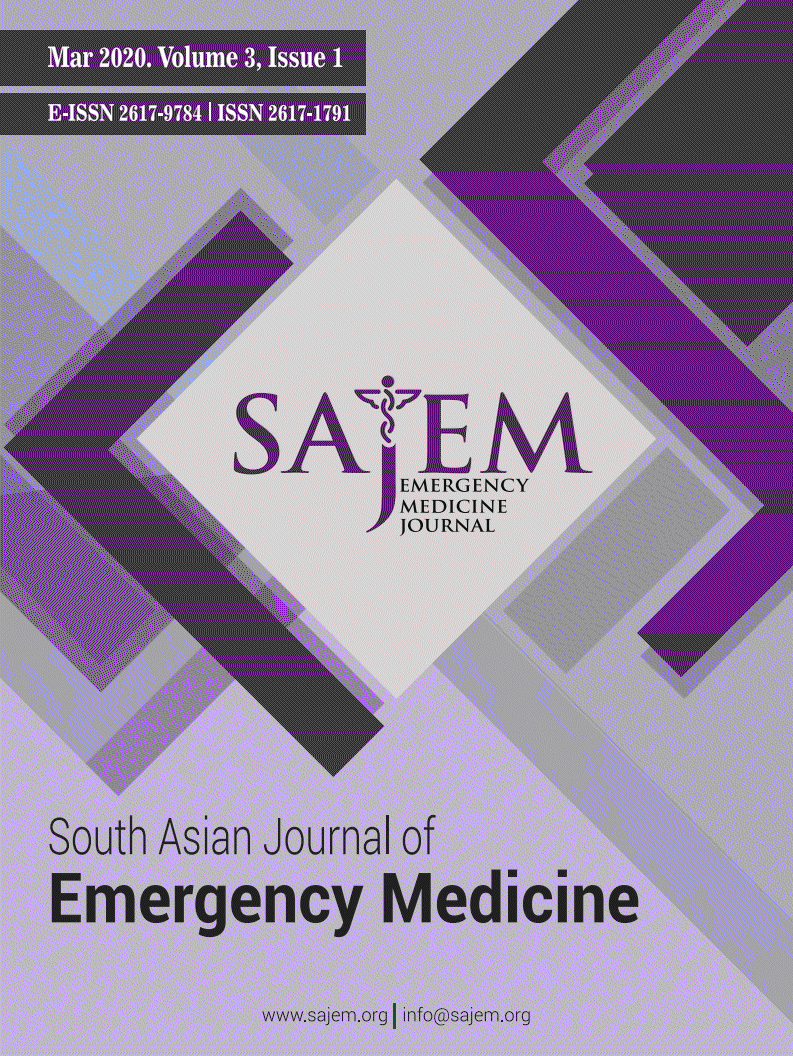
| Original Research Online Published: 26 Aug 2022 | ||
SAJEM. 2021; 4(2): 9-18 doi: 10.5455/sajem.040210 | ||
| How to Cite this Article |
| Pubmed Style Siddiqui EU, Haider S, Baig N, Siddiqui T, Ali N, Khan AS. Clinical Presentation, Prognostic Factors, and Outcomes of Pediatric patients Diagnosed with Acute Myocarditis: A 10-Year Experience from the Emergency Department of a Tertiary Care Hospital.. SAJEM. 2021; 4(2): 9-18. doi:10.5455/sajem.040210 Web Style Siddiqui EU, Haider S, Baig N, Siddiqui T, Ali N, Khan AS. Clinical Presentation, Prognostic Factors, and Outcomes of Pediatric patients Diagnosed with Acute Myocarditis: A 10-Year Experience from the Emergency Department of a Tertiary Care Hospital.. https://www.sajem.org/?mno=63265 [Access: July 03, 2025]. doi:10.5455/sajem.040210 AMA (American Medical Association) Style Siddiqui EU, Haider S, Baig N, Siddiqui T, Ali N, Khan AS. Clinical Presentation, Prognostic Factors, and Outcomes of Pediatric patients Diagnosed with Acute Myocarditis: A 10-Year Experience from the Emergency Department of a Tertiary Care Hospital.. SAJEM. 2021; 4(2): 9-18. doi:10.5455/sajem.040210 Vancouver/ICMJE Style Siddiqui EU, Haider S, Baig N, Siddiqui T, Ali N, Khan AS. Clinical Presentation, Prognostic Factors, and Outcomes of Pediatric patients Diagnosed with Acute Myocarditis: A 10-Year Experience from the Emergency Department of a Tertiary Care Hospital.. SAJEM. (2021), [cited July 03, 2025]; 4(2): 9-18. doi:10.5455/sajem.040210 Harvard Style Siddiqui, E. U., Haider, . S., Baig, . N., Siddiqui, . T., Ali, . N. & Khan, . A. S. (2021) Clinical Presentation, Prognostic Factors, and Outcomes of Pediatric patients Diagnosed with Acute Myocarditis: A 10-Year Experience from the Emergency Department of a Tertiary Care Hospital.. SAJEM, 4 (2), 9-18. doi:10.5455/sajem.040210 Turabian Style Siddiqui, Emad Uddin, Sohaib Haider, Noor Baig, Tooba Siddiqui, Noman Ali, and Abdus Salam Khan. 2021. Clinical Presentation, Prognostic Factors, and Outcomes of Pediatric patients Diagnosed with Acute Myocarditis: A 10-Year Experience from the Emergency Department of a Tertiary Care Hospital.. South Asian Journal of Emergency Medicine, 4 (2), 9-18. doi:10.5455/sajem.040210 Chicago Style Siddiqui, Emad Uddin, Sohaib Haider, Noor Baig, Tooba Siddiqui, Noman Ali, and Abdus Salam Khan. "Clinical Presentation, Prognostic Factors, and Outcomes of Pediatric patients Diagnosed with Acute Myocarditis: A 10-Year Experience from the Emergency Department of a Tertiary Care Hospital.." South Asian Journal of Emergency Medicine 4 (2021), 9-18. doi:10.5455/sajem.040210 MLA (The Modern Language Association) Style Siddiqui, Emad Uddin, Sohaib Haider, Noor Baig, Tooba Siddiqui, Noman Ali, and Abdus Salam Khan. "Clinical Presentation, Prognostic Factors, and Outcomes of Pediatric patients Diagnosed with Acute Myocarditis: A 10-Year Experience from the Emergency Department of a Tertiary Care Hospital.." South Asian Journal of Emergency Medicine 4.2 (2021), 9-18. Print. doi:10.5455/sajem.040210 APA (American Psychological Association) Style Siddiqui, E. U., Haider, . S., Baig, . N., Siddiqui, . T., Ali, . N. & Khan, . A. S. (2021) Clinical Presentation, Prognostic Factors, and Outcomes of Pediatric patients Diagnosed with Acute Myocarditis: A 10-Year Experience from the Emergency Department of a Tertiary Care Hospital.. South Asian Journal of Emergency Medicine, 4 (2), 9-18. doi:10.5455/sajem.040210 |







